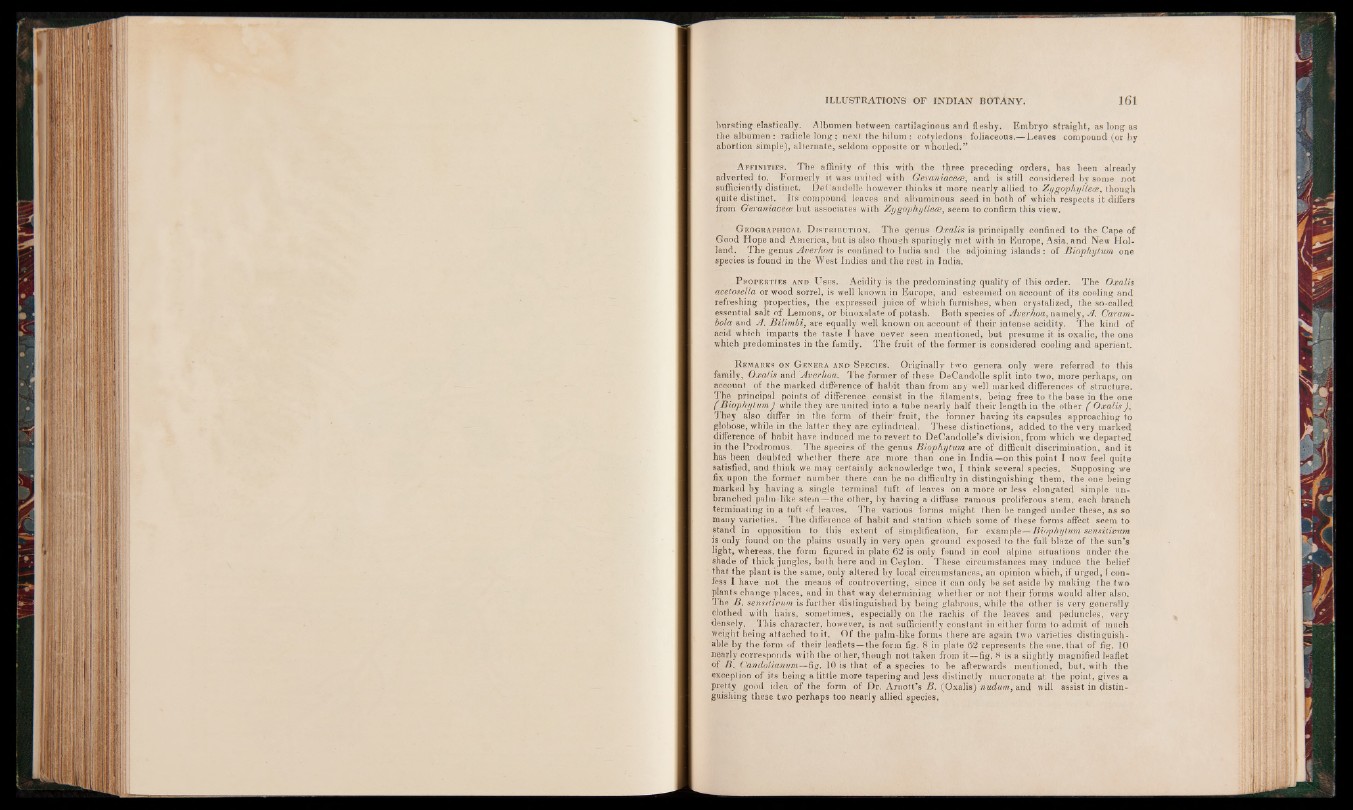
bursting elastically. Albumen between cartilaginous and fleshy. Embryo straight, as long as
the albumen: radicle long; next the hilum: cotyledons foliaceous.— Leaves compound (or by
abortion simple), alternate, seldom opposite or whorled.”
A ffinities. The affinity of this with the three preceding orders, has been already
adverted to. Formerly it was united with Geraniacece, and is still considered by some not
sufficiently distinct. DeCandolle however thinks it more nearly allied to Zygophyllece, though
quite distinct. Its compound leaves and albuminous seed in both of which respects it differs
from Geraniacece but associates with Zygophyllece, seem to confirm this view.
G eographical D istribution. The genus Oxalis is principally confined to the Cape of
Good Hope and America, but is also though sparingly met with in Europe, Asia, and New Holland.
The genus Averhoa is confined to India and the adjoining islands : of Biophytum one
species is found in the West Indies and the rest in India.
P roperties and Uses. Acidity is the predominating quality of this order. The Oxalis
acetosella or wood sorrel, is well known in Europe, and esteemed on account of its cooling and
refreshing properties, the expressed juice of which furnishes, when crystalized, the so-called
essential salt of Lemons, or binoxalate of potash. Both species of Averhoa, namely, A. Caram-
bola and A. Bilimbi, are equally well known on account of their intense acidity. The kind of
acid which imparts the taste I have never seen mentioned, but presume it is oxalic, the one
which predominates in the family. The fruit of the former is considered cooling and aperient.
R emarks on G enera and Species. Originally two genera only were referred to this
family, Oxalis and Averhoa. The former of these DeCandolle split into two, more perhaps, on
account of the marked difference of habit than from any well marked differences of structure.
The principal points of difference consist in the filaments, being free to the base in the one
( Biophytum ) while they are united into a tube nearly half their length in the other ( Oxalis).
They also differ in the form of their fruit, the former having its capsules approaching to
globose, while in the latter they are cylindrical. These distinctions, added to the very marked
difference of habit have induced me to revert to DeCandolle’s division, from which we departed
in the Prodromus. The species of the genus Biophytum are of difficult discrimination, and it
has been doubted whether there are more than one in India—on this point I now feel quite
satisfied, and think we may certainly acknowledge two, I think several species. Supposing we
fix upon the former number there can be no difficulty in distinguishing them, the one being
marked by having a single terminal tuft of leaves on a more or less elongated simple unbranched
palm-like stem—the other, by having a diffuse ramous proliferous stem, each branch
terminating in a tuft of leaves. 'The various forms might then be ranged under these, as so
many varieties. The difference of habit and station which some of these forms affect seem to
stand in opposition to this extent of simplification, for example—Biophytum sensitivum
is only found on the plains usually in very open ground exposed to the full blaze of the sun’s
light, whereas, the form figured in plate 62 is only found in cool alpine situations under the
shade of thick jungles, both here and in Ceylon. These circumstances may induce the belief
that the plant is the same, only altered by local circumstances, an opinion which, if urged, I confess
I have not the means ot controverting, since it can only be set aside by making the two
plants change places, and in that way determining whether or not their forms would alter also.
The B. sensitivum is further distinguished by being glabrous, while the other is very generally
clothed with hairs, sometimes, especially on the rachis of the leaves and peduncles, very
densely. This character, however, is not sufficiently constant in either form to admit of much
weight being attached to it. Of the palm-like forms there are again two varieties distinguishable
by the form of their leaflets—the form fig. 8 in plate 62 represents the one, that of fig. 10
nearly corresponds with the other, though not taken from it—fig. 8 is a slightly magnified leaflet
of B. Candolianum—fig. 10 is that of a species to be afterwards mentioned, but, with the
exception of its being a little more tapering and less distinctly mucronate at the point, gives a
pretty good idea of the form of Dr. Arnott’s B. (Oxalis) nudum, and will assist in distinguishing
these two perhaps too nearly allied species.